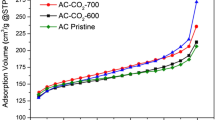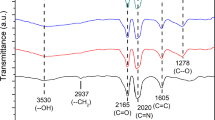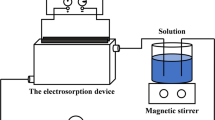Abstract
This present investigation emphasizes on pros and cons of humic acid (HA) on electrosorption behaviour and performance efficiency of capacitive deionization (CDI) process. Electrosorptive removal of HA was examined by lab scale CDI flow cell under 100 ppm Na2SO4 as a supporting electrolyte. In addition, the electrosorption capacitance and desalination performances were also evaluated through cyclic voltammetry studies. In this perspective, we employed the carbon-based electrodes such as chemically treated activated carbon cloth (ACC), carbon aerogel electrodes grade-I (CA-I) and carbon aerogel electrode grade-II (CA-II) with active surface area for 1 cm2 and 24 cm2 respectively. The specific capacitance values of 30, 23 and 10 F g-1 were achieved for ACC, CA-1 and CA-II with 100 ppm Na2SO4 and 10 ppm HA electrolyte solution. The experimental results substantiated that ACC electrode exhibited higher removal efficiency compared to other two carbon electrodes (CA-I and CA-II). Eventually, the electrosorption removal of natural organic matter HA was observed as 15% for CA-I, 30% for CA-II and 58% for ACC electrodes in a CDI flow cell.













Similar content being viewed by others
Data availability
Not applicable.
References
Anderson MA, Cudero AL, Palma J (2010) Capacitive deionization as an electrochemical means of saving energy and delivering clean water. Comparison to present desalination practices: Will it compete? Electrochim Acta 55:3845–3856. https://doi.org/10.1016/j.electacta.2010.02.012
Biesheuvel PM, Van Limpt B, Van Der Wal A (2009) Dynamic adsorption / desorption process model for capacitive deionization. J Phys Chem C 113:5636–5640. https://doi.org/10.1021/jp809644s
Chen L, Wang C, Liu S, Hu Q, Zhu L, Cao C (2018) Investigation of the long-term desalination performance of membrane capacitive deionization at the presence of organic foulants. Chemosphere 193:989–997. https://doi.org/10.1016/j.chemosphere.2017.11.130
Chen Z, Xu X, Ding Z, Wang K, Sun X, Lu T, Konarova M, Eguchi M, Shapter JG, Pan L, Yamauchi Y (2021) Ti3C2 MXenes-derived NaTi2(PO4)3/MXene nanohybrid for fast and efficient hybrid capacitive deionization performance. Chem Eng J 407:127148. https://doi.org/10.1016/j.cej.2020.127148
Choi J, Dorji P, Shon HK, Hong S (2019) Applications of capacitive deionization: desalination, softening, selective removal, and energy efficiency. Desalination 449:118–130. https://doi.org/10.1016/j.desal.2018.10.013
Dąbrowski A (2001) Adsorption — from theory to practice. Adv Colloid Interf Sci 93:135–224. https://doi.org/10.1016/S0001-8686(00)00082-8
Fischer AE, Pettigrew KA, Rolison DR, Stroud RM, Long JW (2007) Incorporation of homogeneous, nanoscale MnO2 within ultraporous carbon structures via self-limiting electroless deposition: Implications for electrochemical capacitors. Nano Lett 7:281–286. https://doi.org/10.1021/nl062263i
Gabelich CJ, Tran TD, Suffet IH“M” (2002) Electrosorption of inorganic salts from aqueous solution using carbon aerogels. Environ Sci Technol 36:3010–3019. https://doi.org/10.1021/es0112745
Ghodbane I, Nouri L, Hamdaoui O, Chiha M (2008) Kinetic and equilibrium study for the sorption of cadmium(II) ions from aqueous phase by eucalyptus bark. J Hazard Mater 152:148–158. https://doi.org/10.1016/j.jhazmat.2007.06.079
Hassanvand A, Chen GQ, Webley PA, Kentish SE (2019) An investigation of the impact of fouling agents in capacitive and membrane capacitive deionisation. Desalination 457:96–102. https://doi.org/10.1016/j.desal.2019.01.031
Huang Z, Lu L, Cai Z, Ren ZJ (2016) Individual and competitive removal of heavy metals using capacitive deionization. J Hazard Mater 302:323–331. https://doi.org/10.1016/j.jhazmat.2015.09.064
Kim YJ, Choi JH (2010) Enhanced desalination efficiency in capacitive deionization with an ion-selective membrane. Sep Purif Technol 71:70–75. https://doi.org/10.1016/j.seppur.2009.10.026
Kim YJ, Hur J, Bae W, Choi JH (2010) Desalination of brackish water containing oil compound by capacitive deionization process. Desalination 253:119–123. https://doi.org/10.1016/j.desal.2009.11.022
Lado JJ, Pérez-Roa RE, Wouters JJ, Tejedor-Tejedor MI, Federspill C, Ortiz JM, Anderson MA (2017) Removal of nitrate by asymmetric capacitive deionization. Sep Purif Technol 183:145–152. https://doi.org/10.1016/j.seppur.2017.03.071
Lee LY, Ng HY, Ong SL, Tao G, Kekre K, Viswanath B, Lay W, Seah H (2009) Integrated pretreatment with capacitive deionization for reverse osmosis reject recovery from water reclamation plant. Water Res 43:4769–4777. https://doi.org/10.1016/j.watres.2009.08.006
Li H, Gao Y, Pan L et al (2008) Electrosorptive desalination by carbon nanotubes and nanofibres electrodes and ion-exchange membranes. Water Res 42:4923–4928. https://doi.org/10.1016/j.watres.2008.09.026
Li L, Zou L, Song H, Morris G (2009) Ordered mesoporous carbons synthesized by a modified sol-gel process for electrosorptive removal of sodium chloride. Carbon N Y 47:775–781. https://doi.org/10.1016/j.carbon.2008.11.012
Li H, Zou L, Pan L, Sun Z (2010) Using graphene nano-flakes as electrodes to remove ferric ions by capacitive deionization. Sep Purif Technol 75:8–14. https://doi.org/10.1016/j.seppur.2010.07.003
Li Y, Liu Y, Wang M, Xu X, Lu T, Sun CQ, Pan L (2018) Phosphorus-doped 3D carbon nanofiber aerogels derived from bacterial-cellulose for highly-efficient capacitive deionization. Carbon N Y 130:377–383. https://doi.org/10.1016/j.carbon.2018.01.035
Liao AA, Spitzer M, Motheo AJ, Bertazzoli R (2008) Electrocombustion of humic acid and removal of algae from aqueous solutions. J Appl Electrochem 38:721–727. https://doi.org/10.1007/s10800-008-9502-x
Liu D, Wang X, Xie YF, Tang HL (2016) Effect of capacitive deionization on disinfection by-product precursors. Sci Total Environ 568:19–25. https://doi.org/10.1016/j.scitotenv.2016.05.219
Liu X, Whitacre JF, Mauter MS (2018) Mechanisms of humic acid fouling on capacitive and insertion electrodes for electrochemical desalination. Environ Sci Technol 52:12633–12641. https://doi.org/10.1021/acs.est.8b03261
Liu Y, Gao X, Wang Z, Wang K, Dou X, Zhu H, Yuan X, Pan L (2021) Controlled synthesis of bismuth oxychloride-carbon nanofiber hybrid materials as highly efficient electrodes for rocking-chair capacitive deionization. Chem Eng J 403:126326. https://doi.org/10.1016/j.cej.2020.126326
Mercê ALR, Lopes PP, Mangrich AS, Levy NM (2006) Molybdenum (VI) binded to humic and nitrohumic acid models in aqueous solutions. Salicylic, 3-nitrosalicylic, 5-nitrosalicylic and 3,5 dinitrosalicylic acids, part 2. J Braz Chem Soc 17:482–490. https://doi.org/10.1590/S0103-50532006000300008
Mossad M, Zou L (2013) Study of fouling and scaling in capacitive deionisation by using dissolved organic and inorganic salts. J Hazard Mater 244–245:387–393. https://doi.org/10.1016/j.jhazmat.2012.11.062
Mossad M, Zhang W, Zou L (2013) Using capacitive deionisation for inland brackish groundwater desalination in a remote location. Desalination 308:154–160. https://doi.org/10.1016/j.desal.2012.05.021
Oh HJ, Lee JH, Ahn HJ, Jeong Y, Kim YJ, Chi CS (2006) Nanoporous activated carbon cloth for capacitive deionization of aqueous solution. Thin Solid Films 515:220–225. https://doi.org/10.1016/j.tsf.2005.12.146
Oren Y (2008) Capacitive deionization (CDI) for desalination and water treatment — past, present and future (a review). Desalination 228:10–29. https://doi.org/10.1016/j.desal.2007.08.005
Pan L, Wang X, Gao Y, Zhang Y, Chen Y, Sun Z (2009) Electrosorption of anions with carbon nanotube and nanofibre composite film electrodes. Desalination 244:139–143. https://doi.org/10.1016/j.desal.2008.05.019
Peña-méndez ME, Havel J, Patočka J (2005) Humic substances – compounds of still unknown structure : applications in agriculture, industry, environment, and biomedicine. J Appl Biomed 3:13–24 https://assets.motherearthlabs.com/resources/4.humic_.substances.compnds.of_.unkwn_.structure2005.pdf
Porada S, Bryjak M, Van Der Wal A, Biesheuvel PM (2012) Effect of electrode thickness variation on operation of capacitive deionization. Electrochim Acta 75:148–156. https://doi.org/10.1016/j.electacta.2012.04.083
Porada S, Zhao R, Van Der Wal A et al (2013) Review on the science and technology of water desalination by capacitive deionization. Prog Mater Sci 58:1388–1442. https://doi.org/10.1016/j.pmatsci.2013.03.005
Qin M, Deshmukh A, Epsztein R, Patel SK, Owoseni OM, Walker WS, Elimelech M (2019) Comparison of energy consumption in desalination by capacitive deionization and reverse osmosis. Desalination 455:100–114. https://doi.org/10.1016/j.desal.2019.01.003
Ryoo MW, Seo G (2003) Improvement in capacitive deionization function of activated carbon cloth by titania modification. Water Res 37:1527–1534. https://doi.org/10.1016/S0043-1354(02)00531-6
Seidel A, Elimelech M (2002) Coupling between chemical and physical interactions in natural organic matter (NOM) fouling of nanofiltration membranes: implications for fouling control. J Membr Sci 203:245–255. https://doi.org/10.1016/S0376-7388(02)00013-3
Shannon MA, Bohn PW, Elimelech M, Georgiadis JG, Mariñas BJ, Mayes AM (2008) Science and technology for water purification in the coming decades. Nature 452:301–310. https://doi.org/10.1038/nature06599
Suss ME, Porada S, Sun X, Biesheuvel PM, Yoon J, Presser V (2015) Water desalination via capacitive deionization: what is it and what can we expect from it? Energy Environ Sci 8:2296–2319. https://doi.org/10.1039/c5ee00519a
Sutton R, Sposito G (2005) Molecular structure in soil humic substances: the new view. Environ Sci Technol 39:9009–9015. https://doi.org/10.1021/es050778q
Suwal S, Doyen A, Bazinet L (2015) Characterization of protein, peptide and amino acid fouling on ion-exchange and filtration membranes: review of current and recently developed methods. J Membr Sci 496:267–283. https://doi.org/10.1016/j.memsci.2015.08.056
Tang CY, Kwon YN, Leckie JO (2007) Fouling of reverse osmosis and nanofiltration membranes by humic acid—effects of solution composition and hydrodynamic conditions. J Membr Sci 290:86–94. https://doi.org/10.1016/j.memsci.2006.12.017
Tang W, Kovalsky P, He D, Waite TD (2015) Fluoride and nitrate removal from brackish groundwaters by batch-mode capacitive deionization. Water Res 84:342–349. https://doi.org/10.1016/j.watres.2015.08.012
Tao G, Viswanath B, Kekre K, Lee LY, Ng HY, Ong SL, Seah H (2011) RO brine treatment and recovery by biological activated carbon and capacitive deionization process. Water Sci Technol 64:77–82. https://doi.org/10.2166/wst.2011.604
Thamilselvan A, Nesaraj AS, Noel M, James EJ (2015) Effect of chemically treated / untreated carbon cloth: potential use as electrode materials in the capacitive deionization process of desalination of aqueous salt solution. J Electrochem Sci Technol 6:139–145. https://doi.org/10.5229/JECST.2015.6.4.139
Thamilselvan A, Nesaraj AS, Noel M (2016) Review on carbon-based electrode materials for application in capacitive deionization process. Int J Environ Sci Technol 13:2976. https://doi.org/10.1007/s13762-016-1061-9
Thamilselvan A, Govindan K, Nesaraj AS, Maheswari SU, Oren Y, Noel M, James EJ (2018) Investigation on the effect of organic dye molecules on capacitive deionization of sodium sulfate salt solution using activated carbon cloth electrodes. Electrochim Acta 279:33. https://doi.org/10.1016/j.electacta.2018.05.053
Wang Z, Wang Y, Ma D, Xu S, Wang J (2018) Investigations on the fouling characteristics of ion-doped polypyrrole/carbon nanotube composite electrodes in capacitive deionization by using half cycle running mode. Sep Purif Technol 192:15–20. https://doi.org/10.1016/j.seppur.2017.09.004
Wang C, Chen L, Zhu L (2019a) Effect of combined fouling on desalination performance of membrane capacitive deionization (MCDI) during long-term operation. J Dispers Sci Technol 41:1–10. https://doi.org/10.1080/01932691.2019.1579654
Wang Z, Xu X, Kim J, Malgras V, Mo R, Li C, Lin Y, Tan H, Tang J, Pan L, Bando Y, Yang T, Yamauchi Y (2019b) Nanoarchitectured metal-organic framework/polypyrrole hybrids for brackish water desalination using capacitive deionization. Mater Horizons 6:1433–1437. https://doi.org/10.1039/c9mh00306a
Xu X, Tang J, Kaneti YV, Tan H, Chen T, Pan L, Yang T, Bando Y, Yamauchi Y (2020) Unprecedented capacitive deionization performance of interconnected iron-nitrogen-doped carbon tubes in oxygenated saline water. Mater Horizons 7:1404–1412. https://doi.org/10.1039/c9mh01829h
Zhang W, Mossad M, Zou L (2013) A study of the long-term operation of capacitive deionisation in inland brackish water desalination. Desalination 320:80–85
Acknowledgements
The authors would like to thank the water Technology Initiative program, Department of Science and Technology (DST), Government of India, New Delhi, for awarding financial grant (Ref. No. DST/TM/WTI/2k11/213(c)) and Karunya Institute of Technology and Sciences for providing the lab facilities to carry out this present research work. Dr. Annadurai Thamilselvan thanks the Science and Engineering Research Board, Department of Science and Technology, Government of India for the award of National Postdoctoral Fellowship (PDF/2017/000564). We would also like to thank Mr. R. Jayakumar and Mr. A. Ruban for his support in fabricating the CDI flow cell system.
Funding
The authors received support from the Department of Science and Technology (DST), Government of India, New Delhi, for awarding financial grant (Ref. No. DST/TM/WTI/2k11/213(c)) and (PDF/2017/000564).
Author information
Authors and Affiliations
Contributions
All persons who meet authorship criteria are listed as authors, and all authors certify that they have participated sufficiently in the work to take public responsibility for the content, including participation in the concept, design, analysis, writing, or revision of the manuscript. Furthermore, each author certifies that this material or similar material has not been and will not be submitted to or published in any other publication before its appearance in the Environmental Science and Pollution Research.
Conception and design of study: Annadurai Tamilselvan, A. Samson Nesaraj, Michael Noel,
Acquisition of data: Annadurai Tamilselvan and A. Samson Nesaraj
Analysis and/or interpretation: Annadurai Tamil Selvan, Kadarkarai Govindan and Subramanian Uma Maheshwari,
Drafting of Manuscript: Annadurai Tamilselvan, Kadarkarai Govindan, and Subramanian Uma Maheshwari
Revising the manuscript critically for important intellectual content:
Kadarkari Govindan,
Subramanian Uma Maheswhari,
A. Samson Nesaraj, and
Michael Noel
Corresponding author
Ethics declarations
Ethics approval
Not applicable.
Consent to participate
Not applicable.
Consent for publication
Not applicable.
Competing interests
The authors declare no competing interests.
Additional information
Responsible Editor: Philippe Garrigues
Publisher’s note
Springer Nature remains neutral with regard to jurisdictional claims in published maps and institutional affiliations.
Rights and permissions
About this article
Cite this article
Thamilselvan, A., Govindan, K., Nesaraj, A.S. et al. Investigation of carbonaceous materials electrosorption attributes and its performance for capacitive deionization process within the presence of humic acid. Environ Sci Pollut Res 30, 71714–71725 (2023). https://doi.org/10.1007/s11356-021-15542-6
Received:
Accepted:
Published:
Issue Date:
DOI: https://doi.org/10.1007/s11356-021-15542-6




